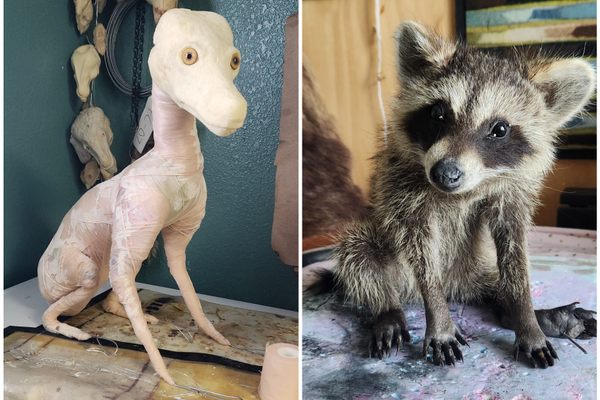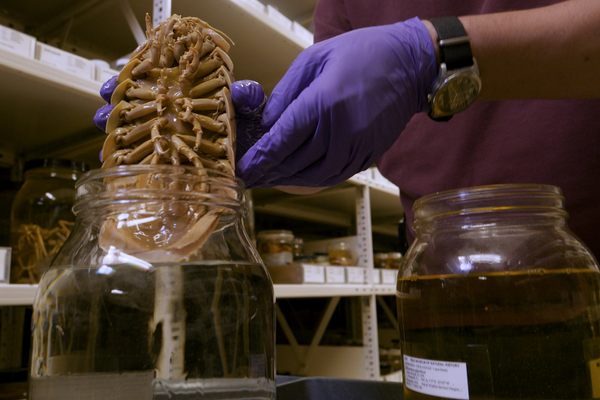A Pair of WWII Bunkers in New Orleans Contains 7 Million Fish
Meet the Royal D. Suttkus Collection.
Hidden in a bend of the Mississippi River just south of New Orleans, 29 concrete bunkers lie on a grid of dirt and grass roads. Some hold remnants from the past—40-year-old gas masks and biohazard signs still hang on a wall. Most of them have been abandoned for decades. But inside two of those bunkers, 15 million fish eyes stare at the walls through the glass of their jars. This is the Royal D. Suttkus Fish Collection, the largest collection of preserved fish in the world, and almost no one knows it exists.
In the Type Room, Dr. Henry Bart—curator of the collection and director of the Tulane Biodiversity Research Institute (TUBRI, which houses the collection)—shows me the rare fish.
It is a small room, maybe the size of a car, but it is the most important room of the institution because it’s where the holotypes and paratypes are kept. “These are the most important specimens because they bear the names, so if there’s any doubt about what a species is, these are what you consult,” Bart says. Here is the famous pocket shark, a small deep-water marine shark found just a few years ago in the Gulf of Mexico—only the second one known to exist in the world. Here is a harelip sucker collected in 1893. It’s been extinct since that year. The tail fins have eroded off, and I can see its brain. Here is the oldest fish in the collection—a shiny minnow collected in Italy in 1838.

As Bart picks up jars of fish, the species’ names roll off his tongue as if he grew up fluent in Latin. “We keep these specimens here because we’re trying to protect them from fire…We have to keep a lot of protections in place,” he says. We are surrounded by cinder block—a fortified vault in a hurricane-proof, tornado-proof, bomb-proof, and camouflaged mausoleum. In the main room down the hall, rows and rows of sea-green shelves hold over seven million other fish.

The history of how the collection came to exist in this place is so storied and mysterious that it could only have happened in the Cajun bayou. Over 260 years ago this swampland was the site of a French, American, and Spanish military fort, after which it was thought to be a plantation, and then later a freedman’s village. The bunkers were built during World War II for the Navy to hold artillery for war ships, and then during the Cold War, the CIA used the property as a training facility. Once the Cold War ended, the government no longer had a use for the property, so they leased it to Tulane University for $1. At first, Tulane used several bunkers for medical research and other natural history collections, but now only the fish remain.
The Royal D. Suttkus Fish Collection was founded in 1950 when the legendary ichthyologist Royal D. Suttkus, who had a hand in collecting over five million of the collection’s fish, joined the faculty at Tulane. The collection was originally housed on the university’s main campus, but by 1968, it had outgrown its space and was moved to its current bunker-home in Belle Chasse, Louisiana. Before Suttkus retired from his position as director, he asked Bart, who had volunteered for him as a student, to apply for the director job. Bart is one of only around four or five hundred ichthyologists working in the country.

Today the collection has approximately 204,291 lots (or containers of the same species that were collected together) holding between seven and eight million specimens, mostly from the freshwaters of the Gulf South. In the ichthyology world, the Suttkus Collection is a vital resource. Each year, Bart and his team mail hundreds of preserved fish to ichthyologists around the world, and scientists travel to New Orleans to research the larger fish in person. These researchers are examining relationships between species and discovering new ones, learning new information about the deepest parts of the ocean, and studying the effects of global warming. “Essentially, we are the holders of history,” explains Justin Mann, the collections manager.
In the bunker that holds the large fish, Mann warns me to stand back before opening a tank the size of a truck bed. The evaporated alcohol from the isopropyl that preserves the fish collects at the top of the tank, and the smell is nearly suffocating at first. Creatures far larger than human bodies lie on top of one another inside. Mann puts one rubber glove on before reaching in, but he doesn’t bother with the other. “You’re touching that with your bare hands,” I acknowledge. He laughs. In the tank are the largest fish in the collection. Mann holds up each of them to show me—the gar, the sturgeon, the paddlefish. At around eight feet long, the bramble shark is the largest. This one was only the third ever found in the Gulf of Mexico. He grabs a large rubbery piece from the top of the fish pile and adds, “Oh, here’s the liver,” and goes on to explain how they use their livers as buoyancy control and to process salt.

Though collections like this outnumber public museums, they’ve recently started disappearing. Last year, the keepers of the fish collection at the University of Louisiana at Monroe were told they had just 48 hours to find a new location for their fish because their space was needed to renovate the running track. Tulane and a handful of other universities collectively offered to take in their collection, and overnight, the Suttkus Collection acquired 85,000 new specimens. Ironically, ULM had already absorbed another university’s collection when it closed. Around the country, natural history collections are worried this might happen to them next. “This has been happening for a while, but recently, as funding has dropped significantly, a lot more collections like ours are being consolidated or redistributed, or just left to rot,” Mann says.
The recent development of genetic research has played a role in the loss of funding. Because genetics research requires only a tissue sample, some people feel that collections that preserve the entire fish are no longer useful. And while there are great benefits to using genetic research, Mann does not view it as a replacement for specimen collections. “If you are describing a species and you’re focusing so much on genetic material that you ignore archive material, you’re only getting half the picture,” he says. But government agencies are more likely to fund the newest technology, and the amount they have to distribute is rapidly decreasing. The current administration’s unwillingness to invest in science is a major cause of concern for the entire science community, and especially for collection like this one. “For a long time, it was just us justifying our existence to these agencies,” Mann says. “Now these agencies are having to justify our existence to the administration as a whole, and that’s scary for us…The funding has shrunk, and the competition has gotten a lot harder.”

The Suttkus Collection is lucky in that they receive support from Tulane, but the budgetary constraints of the university, in addition to the decrease in government funding, has proven to be a major challenge. One of Bart’s major goals is to raise enough money to create an endowed position with a reliable source of funding, but finding donors has been difficult since few people have heard of the collection. Because the property was not designed to accommodate visitors, they do not have the capacity to open to the public, and so they remain an unintentional secret outside of the ichthyology bubble.
But Mann is trying to change that. He’s recently started to do outreach projects to spread the word that the collection exists, that it’s important, and that it needs the public’s support. The situation is even more precarious because of the property. The land itself is an unofficial wildlife preserve and a trove of archeological treasures and history waiting to be discovered.
Jonathan Walczak is an investigative journalist and archivist hired by TUBRI to collect and piece together notes of Royal D. Suttkus that were damaged or lost during Hurricane Katrina. “I don’t even know how to describe in a quick way what I do, so I just jokingly tell people that I work in a swamp bunker with 8 million dead fish. Which is accurate.” he says. The property is what fascinates him most.

“It’s a very peaceful place,” he says. “I’m probably 15-20 minutes from my house right now, but also in the middle of nowhere.”
The property spans 360 acres with three dirt roads (Alligator, Armadillo, and Wild Boar). Of the 29 bunkers, two house the Suttkus Collection, and one has the new specimens still being sorted from the ULM collection. The rest of the bunkers are sources of mystery and rumor.
Walczak shows me where the old fort once stood (though it’s been covered by the Mississippi River and is no longer visible), and the area of the property where old maps show a freedman’s village. After studying old documents, he discovered that the CIA secretly used the property during the early 1960s for Cuban dissidents training in underwater demolition (among other things) for the Bay of Pigs invasion, information that’s still not well-documented. Every piece of the property is rich with history waiting to be uncovered. Coyote, deer, hogs, river otters, and alligator roam freely.

“On one hand, we want as many people to know about it as possible because it’s a special place,” Walczak says. “On the other, you worry about the pristine-ness of it being tainted. But if no one knows about us, we’re going to sink into oblivion.” There’s recently been talk of Tulane selling the property, and it’s unclear whether the Suttkus Collection would remain where it is, or what would happen to the property if the collection were moved to a new home. “I worry, especially as empty, vacant land becomes increasingly scarce and the coast gets closer. I worry that this land might one day be developed and I really hope that’s not the case,” Walczak says. “People come and go as funding comes and goes. And I hope that when I’m gone, that somebody cares about the history.”
There’s a storm coming. Charcoal clouds prowl up the river from the Gulf. Wild boar and water moccasins linger nearby. But for now, the fish lie safe in their indestructible lair, holding secrets still undiscovered about our oceans, as they have for decades. The elements can’t hurt them here—it’s humans that are dangerous.



















Follow us on Twitter to get the latest on the world's hidden wonders.
Like us on Facebook to get the latest on the world's hidden wonders.
Follow us on Twitter Like us on Facebook